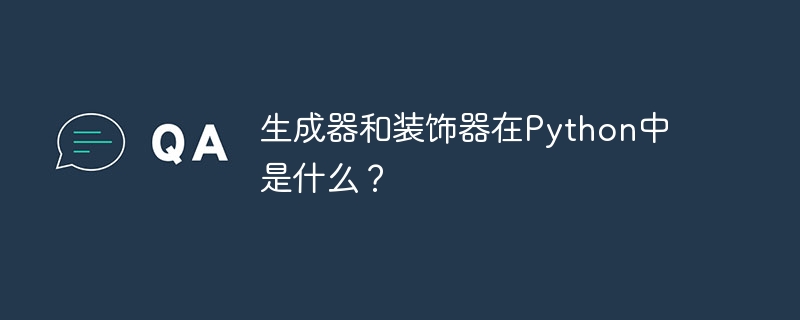生成器和裝飾器在Python中是什麼?
- 王林轉載
- 2023-09-10 22:49:021071瀏覽

在這篇文章中,我們將向您解釋什麼是Python中的生成器和裝飾器。
自從 PEP 255 引入生成器以來,它們一直是 Python 的重要組成部分。
Python 中的生成器是一個特殊的例程,可用來控制循環的迭代行為。生成器類似於傳回數組的函數。生成器有一個參數,我們可以呼叫它並產生一個數字序列。但與傳回整個陣列的函數不同,生成器一次產生一個值,需要更少的記憶體。
任何帶有關鍵字「yield」的Python函數都可以稱為生成器。普通的 python 函數從第一行開始執行,並繼續執行,直到我們收到 return 語句或異常或函數結束,但是,在函數作用域期間創建的任何局部變數都將被銷毀,並且無法進一步存取。而對於生成器來說,當它遇到yield關鍵字時,函數的狀態將被凍結,並且所有變數都將儲存在記憶體中,直到再次呼叫生成器。
我們可以根據迭代器使用生成器,也可以使用「next」關鍵字明確呼叫。
通常是 Python 中的生成器 -
使用 def 關鍵字定義
使用yield關鍵字
#可能包含多個收益關鍵字。
傳回一個迭代器。
生成器是傳回可迭代生成器物件的函數。由於生成器物件中的值是一次取得一個值,而不是一次取得整個列表,因此您可以使用 for 迴圈、next() 或 list() 函數來取得實際值。
生成器函數
可以使用生成器函數和生成器表達式來建立生成器。
產生器函數與常規函數類似,但它沒有傳回值,而是具有yield關鍵字。
要建立生成器函數,請新增 yield 關鍵字。下面的範例示範如何編寫生成器函數。
帶有迭代器的生成器
範例
# creating a function def generatorExample(): yield "T" yield "U" yield "T" yield "O" yield "R" yield "I" yield "A" yield "L" yield "S" # calling the generatorExample() function which is created above result = generatorExample() # Traversing in the above result(generator object) for k in result: # Printing the corresponding value print(k)
輸出
T U T O R I A L S
從生成器讀取產量值
list()、for-loop 和 next() 方法可用於從生成器物件讀取值。
使用 next() 從生成器物件讀取值
next() 方法傳回清單、陣列或物件中的下一項。當列表為空並且呼叫 next() 時,它會傳回一個帶有 stopIteration 訊號的錯誤。此錯誤表示清單中沒有更多條目。
範例
# creating a function that accepts a number as an argument
def oddNumbers(num):
# traversing till that number passed
for i in range(num):
# checking whether the iterator index value is an odd number
if (i%2!=0):
# getting the iterator index value if the condition is true using the yield keyword
yield i
# calling the above function to get the odd numbers below 8
result = oddNumbers(8)
# calling the next items in the result list
print(next(result))
print(next(result))
print(next(result))
print(next(result))
# throws an error since the list has no more elements
print(next(result))
輸出
1
3
5
7
Traceback (most recent call last):
File "main.py", line 17, in <module>
print(next(result))
StopIteration
Python 中的裝飾器
Python 提供了一個名為裝飾器的神奇工具,用於為現有程式碼新增功能。
這也稱為元程式設計,因為程式的一部分嘗試在編譯時修改程式的另一部分。
裝飾器使用函數作為另一個函數中的參數,然後在包裝函數內呼叫函數。
文法
@tutorials_decorator
def python_decorator():
print("Hello tutorials Point")
'''Above code is equivalent to -
def python_decorator():
print("Hello tutorials Point")
python_decorator = tutorials_decorator(python_decorator)'''
這裡的tutorials_decorator是一個可呼叫函數,它在另一個可呼叫函數python_decorator之上添加一些程式碼並傳回包裝函數。 p>
範例
這裡func是被裝飾的函數,python_decorator是用來裝飾它的函數
# defining a decorator
def python_decorator(func):
def wrapper():
print("Text before calling the function")
func()
print("Text after calling the function")
return wrapper
def tutorials_decorator():
print("Hello tutorials Point!!!")
tutorials_decorator = python_decorator(tutorials_decorator)
tutorials_decorator()
輸出
Text before calling the function Hello tutorials Point!!! Text after calling the function
python_decorator(func) - 這是一個裝飾函數;它接受另一個函數作為參數並「裝飾」它,這意味著它修改它並返回修改後的版本。
wrapper - 我們在裝飾函數中定義了另一個名為 wrapper 的內部函數。這是透過包裝來修改傳遞的函數 func 的實際函數。
包裝函數由裝飾器傳回。
tutorials_decorator - 這是我們需要裝飾的普通函數。這裡只列印一個簡單的語句。
語法裝飾器
上面描述的裝飾器模式在Python社群中流行起來,但它有點複雜。我們必須將函數名稱寫三遍,並且修飾隱藏在函數定義下面。
因此,Python 添加了一種使用裝飾器的新方法,即透過使用 @ 符號 包含語法糖。
文法
@decorator def func(arg1, arg2, ...): pass
語法糖是程式語言中使用的語法,使內容更容易閱讀或表達。
範例
以下範例執行與前一個範例相同的操作 -
# defining a decorator
def python_decorator(func):
def wrapper():
print("Text before calling the function")
func()
print("Text after calling the function")
return wrapper
@python_decorator
def tutorials_decorator():
print("Hello tutorials Point!!!")
tutorials_decorator()
輸出
Text before calling the function Hello tutorials Point!!! Text after calling the function
與前面的範例相同,唯一的差異是我們使用 @python_decorator 而不是
tutorials_decorator = python_decorator(tutorials_decorator)
結論
在本文中,我們簡要地了解了 Python 中的生成器和裝飾器。我們也示範如何在編寫程式碼時使用生成器和裝飾器。
以上是生成器和裝飾器在Python中是什麼?的詳細內容。更多資訊請關注PHP中文網其他相關文章!

